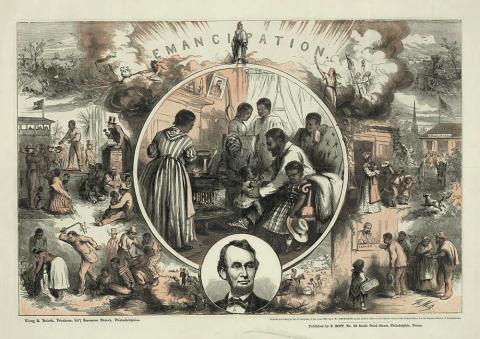
Description
In his 1865 image titled "Emancipation," Thomas Nast celebrates the emancipation of southern slaves with the end of the Civil War by contrasting a life of suffering and pain before the conflict with a life of optimism and freedom afterwards. The central scene shows the interior of a freedman's home with the family gathered around a "Union" wood stove. The father bounces his small child on his knee while his wife and others look on. Below this scene is an oval portrait of Lincoln and above it, Thomas Crawford's statue of "Freedom." On either side of the central picture are scenes contrasting African-American life in the South under the Confederacy (left) with visions of the freedman's life after the war (right). Fugitive slaves, located on the top left, are hunted down in a coastal swamp. Below, a African-American man is sold, apart from his wife and children, on a public auction block. At the bottom, an African-American woman is flogged and a male slave is branded. Above, two hags, one holding the three-headed hellhound Cerberus, preside over these scenes, and flee from the gleaming apparition of Freedom. In contrast, on the right, a woman with an olive branch and scales of justice stands triumphant. Here, a freedman's cottage can be seen in a peaceful landscape. Below, a black mother sends her children off to "Public School." At bottom a free Negro receives his pay from a cashier. Two smaller scenes flank Lincoln's portrait. In one a mounted overseer flogs a black field slave (left); in the other a foreman politely greets Negro cotton-field workers.
Source-Dependent Questions
- Using evidence from the image, explain the artist’s attitude about the future of freed slaves living in the South.
- According to the artist, what were the necessary requirements for a former slave to live a life of freedom?
- How did the artist structure his image to celebrate emancipation?
- What else would you have recommended to the artist that he include in this image?
Citation Information
Nast, Thomas, "Emancipation / Th. Nast ; King & Baird, printers, 607 Sansom Street, Philadelphia," 1865. Courtesy of Library of Congress